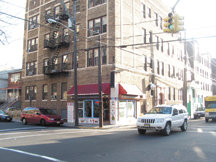Earlier this month, the Union City Board of Commissioners awarded a contract to American Traffic Solutions to install cameras at various intersections in that city, to snap photos of cars running red lights. After the cameras snap photos, the state Department of Transportation will send a ticket to the car’s registered owner.
Union City is one of many municipalities throughout New Jersey hoping to use the cameras to cut down on intersection crashes, and some of the proceeds of the tickets will also go into the cities’ budgets.
However, the city may have to wait a while: Interest in the program has been widespread and state approvals are currently halted.
The state has temporarily halted new approvals.
________
West New York Police Chief Alberto Bringa said last week that he would also consider utilizing the system, but noted that his first priority is installing general monitoring cameras to help police when responding to incidents.
“[The general monitors are] in my future agenda,” said Bringa. “It gives us a better outlook on things that are happening in certain areas.”
The Red Light Running Automated Enforcement Program (RLR) is run by the New Jersey Department of Transportation. Twenty municipalities have already been approved for the cameras under a five-year pilot program that was signed into law by former Governor Corzine in January 2008.
Before cameras are installed in a town, the police department will do research to see which areas of town will benefit most. Temporary cameras will be set up to see what is happening at those intersections. There will be no cost to the city for the research or installation of the cameras.
Everett noted that there are other measures being taken in Union City to prevent crashes, including updating the traffic signals and signs at certain intersections.
“By no means do I think this is the best way to prevent crashes, or the only way,” he said. “There are many things we’re involved with regarding safety and enforcement.”
How it works
The cameras will be provided by American Traffic Solutions, based in Scottsdale, Ariz. Their systems use underground sensors to detect when a vehicle is running a red light, which triggers the camera system. The cameras then capture several pictures of the car, the driver, and the license plate. That information is sent electronically to the company, which will verify the offense. Then the information will be sent to the municipality for a local police officer to sign off on it and the driver will receive a violation notice in the mail with the standard $85 fine. Although the municipality receives the majority of the fine, American Traffic Solutions will receive a percentage of each fine paid.
The owner of the car will be responsible to either pay the fine or go to court to prove it is inaccurate. If the fine is paid, the owner will not receive any points on their license. However, if the matter is taken up in court and the party is found guilty, points will be attached to the summons.
Statewide controversy
According to the New Jersey Department of Transportation, RLR programs have been installed throughout municipalities in 24 states across this country. New York City has had a RLR program in place since 1993.
Last month, New Jersey Monthly reported on the popularity of the program and the controversy surrounding the use of the cameras. Supporters of the cameras say that they work as a deterrent and decrease accidents. However research shows that the cameras may actually increase rear-end accidents in which the drivers are braking at the last minute to avoid getting a ticket.
Some critics of the red-light cameras have said they are more likely to increase municipal revenues than prevent crashes. People rarely fight the violations, and the amount of tickets mailed out per month is quite high in some areas. Newark sent out 3,000 warning notices in their first month of operation.
Critics have also said that there are cheaper alternatives to decrease red-light running, such as increasing yellow-light times and improved signal visibility.
Despite some opposition, municipalities continue to apply to the program. However some, such as South Brunswick, actually withdrew their application after concerns were expressed about the potential for increasing accidents.
The NJDOT website says that their application process for the program is meant to establish locations in the state that have a demonstrated red light-running history. The state also checks to see whether other efforts have been made by the town, such as engineering, enforcement, and education, and whether these efforts have shown to be effective in decreasing violations and/or crashes.
Lana Rose Diaz can be reached at ldiaz@hudsonreporter.com.
